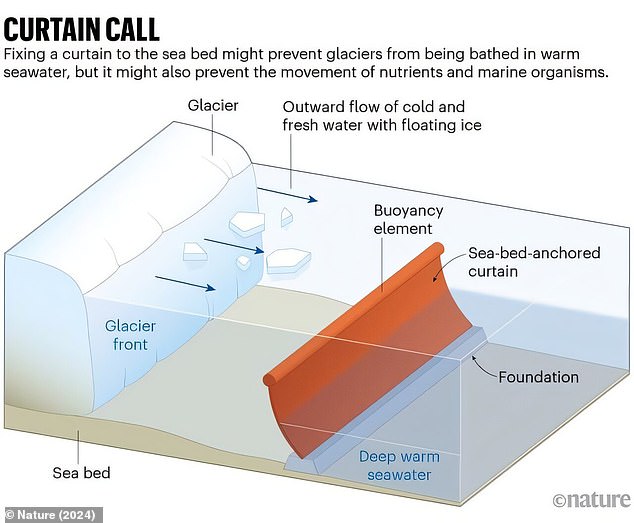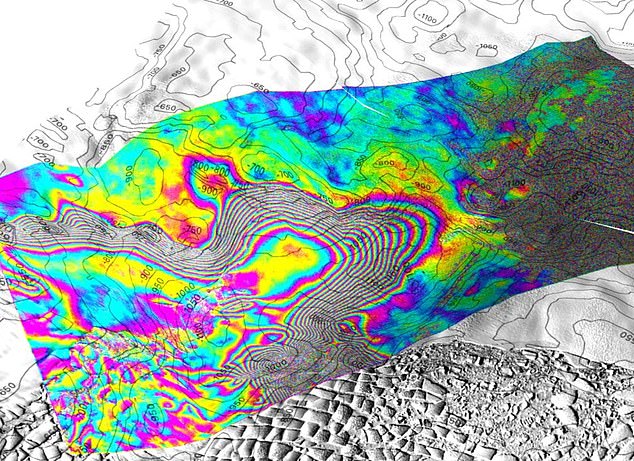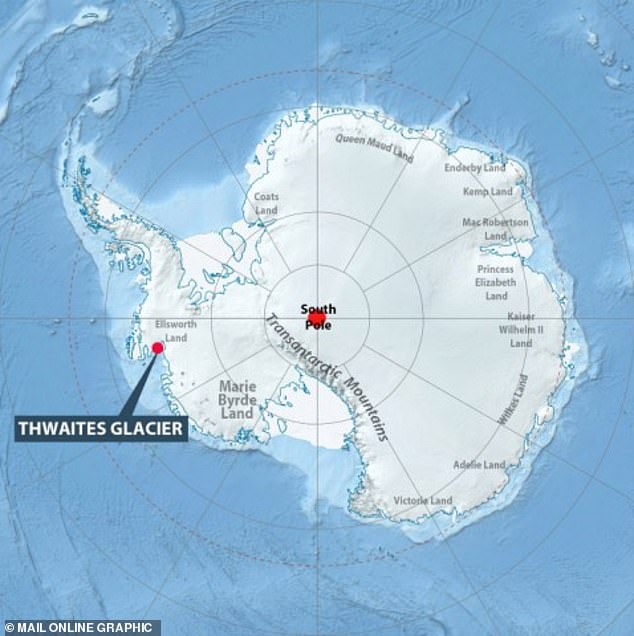A ‘Doomsday Glacier’ that could flood New York and Miami is melting – experts have a radical plan to stop it
Scientists have proposed a radical plan to prevent a massive Antarctic glacier from melting, which would cause catastrophic flooding along the US east coast.
They proposed installing a giant underwater curtain, artificially thickening glaciers with seawater or cooling the rock over which they slide to prevent warm water from reaching the Thwaites Glacier, also known as the ‘Doomsday Glacier’.
The Thwaites Glacier is melting faster and faster due to climate change and would raise global sea levels by 3 meters, flooding coastal cities like New York, Charleston, Atlantic City and Miami.
To prevent this, researchers led by the University of Chicago’s Climate Systems Engineering Initiative published a report calling for a “major initiative” in the coming decades to investigate what interventions, if any, could and should are used.
Douglas MacAyeal, professor of geophysical sciences and co-author of the white paper, said: ‘Our argument is that we need to start funding this research now so that we don’t make panicky decisions along the way while the water is already sloshing. our ankles.’
One proposal in the new report would pump seawater to the surface of Doomsday Glacier, where cold air temperatures would cause it to freeze in place, thickening the glacier.
But the idea comes with risks and costs, the authors warned.
The salinity of seawater can affect the structural integrity of the ice, and the energy required to pump large volumes of seawater poses unresolved problems.
An Antarctic glacier the size of Florida is melting faster than expected. If it collapses, it will cause catastrophic flooding in coastal cities around the world

If the Doomsday Glacier and the West Antarctic Ice Sheet melt, global sea levels would rise by 3 meters (pictured shows a rise of only 1.8 meters), leaving coastal cities like New York, Charleston, Atlantic City and Miami would be flooded.
A British startup called Real Ice has been working on this solution since 2019. Field trials conducted in Canada earlier this year showed promising results, but deploying them at scale would cost about $6 billion per year and require enormous energy input.
These and other interventions discussed in the report are examples of geoengineering solutions. They deliberately alter the planetary environment to counter the effects of human-induced climate change.
Some experts have called the ideas “radical,” saying geoengineering would be “difficult or impossible to achieve, distracting from the more necessary conversation about cutting carbon emissions.”
Gernot Wagner, a climate economist at the Columbia Climate School, said: “When we talk about glacial geoengineering, we have to tell the truth, which is that it is not a solution to climate change – at best it is a painkiller.”
The Doomsday Glacier covers 74,000 square kilometers and loses about 50 billion tons of ice every year, which is responsible for about four percent of global sea level rise.
It also acts as a natural dam that prevents the West Antarctic Ice Sheet (WAIS) – which covers 760,000 square kilometers – from collapsing.
This “vigorous melting” is largely caused by warm tidal currents pumping beneath the glacier, according to a May study published in the journal Proceedings of the National Academy of Sciences (PNAS).
The White Paper, published in July, including results from recent conferences at the University of Chicago and Stanford University on geoengineering.

A team of scientists is urging officials to invest in geoengineering initiatives, such as installing a massive flow to block hot water
Another proposed intervention would be to prevent warm currents from hitting the glacier by erecting a giant underwater curtain in front of it.
This idea was conceived and proposed by glaciologist John Moore of the University of Lapland, who co-authored the white paper.
The curtain would be 100 kilometers long and could cost up to $50 billion to build.
It would anchor at the bottom of the Amundsen Sea and prevent warm undersea currents from hitting the underside of the Thwaites Glacier.
Held up by a floating top edge and anchored at the bottom, the curtain would float at the bottom of the ocean, invisible from the water’s surface.
To achieve this would require a feat of engineering and construction, not to mention a huge financial investment.
It also entails risks. The white paper points out that blocking heat from the voids beneath the ice could have consequences along the entire coast of the Amundsen Sea.
“For example, if the circulation of warm deep water in the region shifts westward, it could affect other ice shelves, potentially reducing their stability, while changing local ecology in uncertain ways,” the report said.

A team of glaciologists used high-resolution satellite images and hydrological data to identify areas where warm tidal currents flow beneath the glacier, causing it to melt faster

The Thwaites Glacier is part of a series of glaciers along the sea-facing edge of the WAIS
But Moore goes ahead with his plan. He previously told DailyMail.com that he and his colleagues were working on computer simulations to get the design right, as well as “some small-scale tank tests, mainly with aquariums.”
Other experts think they can reduce glacier melting by cooling the rock that glaciers slowly slide over.
Glaciers are constantly moving toward the sea, and as they do so their bottom surfaces scrape the underlying bedrock, creating friction and therefore heat that causes them to melt from below.
Michael Wolovick, a glaciologist at Princeton University, thinks he can slow this melting by drilling tunnels into the rock and pumping cold water through it.
This would combat the heat generated by glacier movements and thus reduce melting at the bottom of the glacier.
This idea would cost tens of billions of dollars, and the potential risks associated with it – especially to local ecosystems – require further study.
As researchers sound the alarm about the rapidly increasing melt rate of the Doomsday Glacier, more and more scientists are calling for support for geoengineering projects.
“It will take fifteen to thirty years before we understand enough to recommend or rule out any of these interventions,” Moore said in a statement.
The white paper followed the May PNAS study, which used high-resolution satellite imagery and hydrological data to identify areas where warm tidal currents flow beneath the Doomsday Glacier and cause it to melt faster.
This accelerated melt rate could mean that predictions of global sea level rise need to be reassessed as catastrophic levels arrive sooner than experts previously thought, the researchers concluded.
The loss of the Doomsday Glacier would also lead to the collapse of the WAIS – the continental ice sheet that covers West Antarctica.
The WAIS is essentially a bowl of ice three times the size of Texas, located in a basin located below sea level in West Antarctica.
The Thwaites Glacier is part of a series of glaciers along the sea-facing edge of the WAIS.
These glaciers are the only thing keeping the ocean from filling the WAIS basin and melting or releasing the ice.
If both the Thwaites and WAIS collapse, it would cause irreversible, extreme sea level rise that would endanger millions of people and accelerate the melting of other glaciers around the world.
Climate scientists classify this potential disaster as a “tipping point,” or crossing a critical threshold that leads to major, unstoppable changes in the climate system.
‘We hoped it would take a hundred and five hundred years to get rid of that ice. A big concern right now is whether it happens much faster,” Christine Dow, co-author of the study and associate professor of glaciology at the University of Waterloo, told me. Scientific American.
